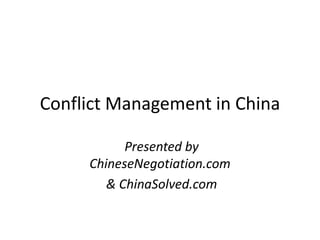
Conflict Management Part 2 The Deadly 7
- 1. Conflict Management in China Presented by ChineseNegotiation.com & ChinaSolved.com
- 2. Conflict Management in China PART II: The 7 Words You Can’t Say in a Chinese Negotiation (without thinking carefully)
- 3. A glossary of conflict laden phrases in Western-Chinese deal making. Resolving conflict in China-Western business relationships is very difficult, but avoiding and controlling conflict is much more practical. Beware of these phrases that SEEM harmless and crystal-clear, but may actually carry a different meaning in China than they do for you.
- 4. Fighting Words: 1. Contract 2. Risk 3. Long Term 4. Truth 5. Harmony / justice. 6. Relationship 7. Transaction www.ChinaSolved.com www.ChineseNegotiation.com
- 5. 1. Contract • Westerners see a contract as an independent entity – external from the two counterparties. • Chinese view a contract as a record of a meeting of the minds between two specific individuals at a certain time and place, under specific circumstances.
- 6. 2. Risk • Risk, as used by Westerners, encompasses two concepts. – A) possibility of loss and – B) uncertainty. • To Westerners, these are two sides of the same coin. • To Chinese, these are completely different things with wildly different ramifications.
- 7. Risk (con’t) • Possibility of loss doesn’t frighten Chinese deal- makers, but uncertainty does. Confronted with an unclear or uncertain future, the wise Chinese deal-maker shuts down and waits for further information. • When the Western side attempts to push him into action, the Chinese side smells trouble, deception and trickery. Conflict and mistrust ensue.
- 8. 3. Long Term • Chinese and Westerners involved in a negotiation frequently accuse the other side of being short sighted, one-off and win-lose, while THEY are long-term, cooperative and win-win. • The irony is each side accuses the other of engaging in the same distrustful, deal- destroying behavior.
- 9. 4. Is it truth – or is it Truth? • Truth, Justice – and the American Way. – Westerners view Truth as an external, universal constant. It is bigger than we mere mortals – or at least bigger than we Westerners. • Asians think that this is nuts. – Everything changes. Price levels, supply chain factors, weather conditions – the world is always in flux. Yin and Yang, ups and downs.
- 10. Truth (con’t) • Westerners: – A man’s word is his bond – or it isn’t . – A righteous Westerner feels that the words you said yesterday bind you today. • Chinese: – A man’s nature is reliable and consistent – or it isn’t. – A righteous Chinese feels that your intentions yesterday bind you today.
- 11. 5. Harmony & Justice. • China isn’t all fluidity and flux. One thing really is bigger than all of us – but it isn’t Truth. It’s Harmony. – Westerners prefer rock-hard Justice – like the kind that judges and courts can dispense. – Chinese prefer soft, eternal Harmony – like that kind that rises from the will of the People. • Both are great – but they don’t live in the same house.
- 12. 6. Relationship. • Westerners tend to view relationships as organic, personal and based on familiarity and shared values. – They are desirable, but not required . – They develop naturally over time. • Chinese view relationships as carefully planned and delicately choreographed. – They are intrinsic to the deal process. – They are systematic and intentional
- 13. 7. Transaction • For Westerners, relationships flow from successful transactions. – Test orders and contractual safeguards are standard operating procedure. – ‘Good fences make good neighbors’ • For Chinese, transactions flow from successful relationships. – Test orders and contracts undermine trusts. – ‘Honest men don’t need contracts – dishonest men aren’t bound by them.’
- 15. For more information: www.ChineseNegotiation.com www.ChinaSolved.com www.AndrewHupert.com Linked group: Chinasolved
